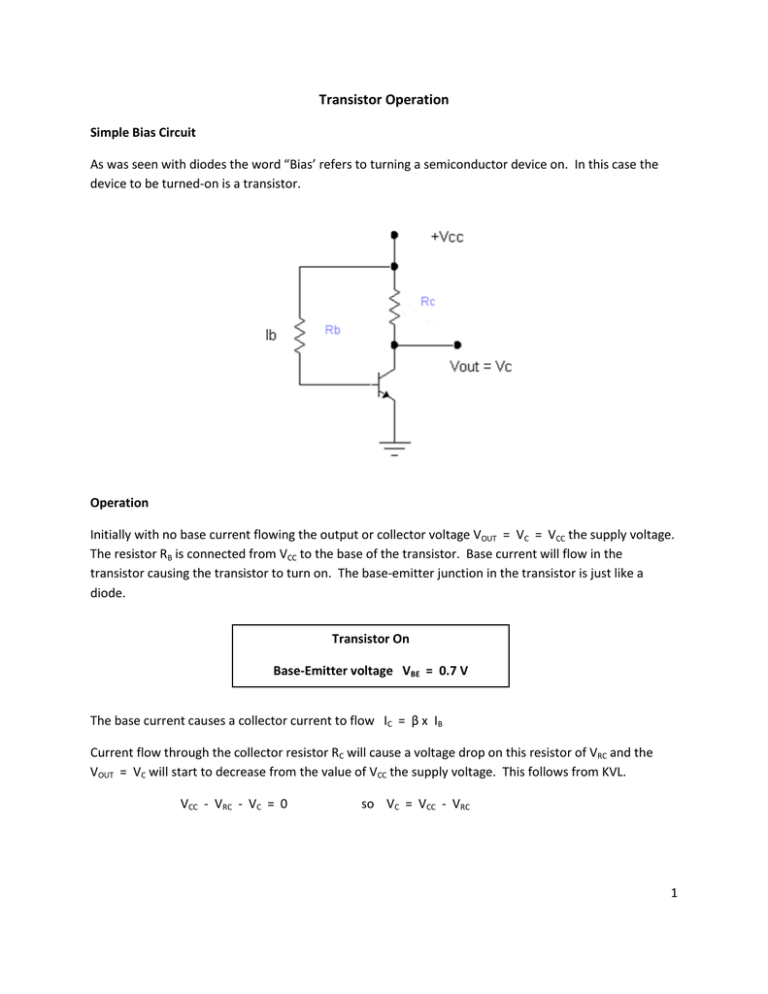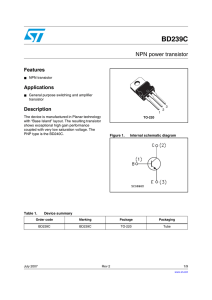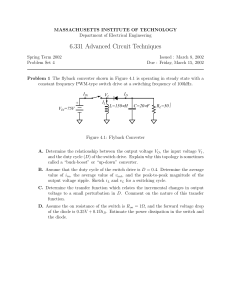Basic Transistor operation.
advertisement

Transistor Operation Simple Bias Circuit As was seen with diodes the word “Bias’ refers to turning a semiconductor device on. In this case the device to be turned-on is a transistor. Operation Initially with no base current flowing the output or collector voltage VOUT = VC = VCC the supply voltage. The resistor RB is connected from VCC to the base of the transistor. Base current will flow in the transistor causing the transistor to turn on. The base-emitter junction in the transistor is just like a diode. Transistor On Base-Emitter voltage VBE = 0.7 V The base current causes a collector current to flow IC = β x IB Current flow through the collector resistor RC will cause a voltage drop on this resistor of VRC and the VOUT = VC will start to decrease from the value of VCC the supply voltage. This follows from KVL. VCC - VRC - VC = 0 so VC = VCC - VRC 1 Example Calculate the values of IB, VBE, IC and VC. Β = 150 IB = (12 V - 0.7 V)/ 270 kΩ = 42 µA IC = β x IB = 150 x 42 µA = 6.28 mA VRC = IC x RC = 6.28 mA x 1 kΩ = 6.28 V VC = 12 V – 6.28 V = 5.72 V Transistor States Cut-Off – Transistor Off State When the transistor is in the Cut-Off state it is not conducting and there are no transistor currents (IB or IC) flowing. In the circuit shown the input voltage VBB is a variable voltage source and it is initially set to 0 volts. 2 With the input voltage set to 0 volts there will be no base current IB. If the base current is zero then the collector current is zero (Why?) and the collector voltage VC will be equal to the supply voltage VCC (Why?). This state is called Cut-off for the transistor. Note: At this point it is also useful to starting referring to VC as the collector-emitter voltage VCE. Characteristics of Transistor Cut-off IC = 0 and VC (or VCE) = VCC Saturation If Cut-Off refers to a transistor that is off, the Saturation state refers to a transistor that is fully on. Consider the previous circuit. If we now start to increase the input voltage VBB, then base current will flow. Collector current will now also start to flow and a voltage drop will develop on the collector resistor RC. The result is that the collector (or collector-emitter) voltage will start decreasing from the value of VCC. If the input voltage VBB is increased further the base and collector currents will continue to increase, the voltage drop on the collector resistor RC will also increase and the collector-emitter voltage will also decrease getting closer to zero volts. At some value of the input voltage the input voltage will be large enough to decrease the collector-emitter voltage to approximately 0 volts. Any further increase in VBB and thus IB will no longer have an effect of the collector current and the collector-emitter voltage – the collector-emitter voltage cannot decrease any more than 0 volts. This state for the transistor is called Saturation. Characteristics of Saturation IC is a maximum value and VCE ≈ 0 V Notes: 1. The value of the maximum collector current IC,Max = IC,Sat = VCC/RC 2. For a saturated transistor VCE = 0.1 to 0.2 V. If VCE is exactly zero then the transistor is likely shorted between the collector and emitter leads and would be considered non-functional. Active Region A further third region of operation can be specified as the Active Region. The Active Region lies between the 2 states of Cut-Off and Saturation and has non-zero collector currents less than the maximum value and a collector-emitter voltage VCE between VCC and 0 volts. 3 Transistor Load Line This graph of VCE vs IC allows the 3 region or states to plotted and seen visually. The Cut-Off, Saturation points and the Active Region are displayed VCE Cut-Off (VCE=VCC, IC=0) Active Region IC Saturation (VCE ≈ 0, Ic,Max) Transistor Switch Application A switch can be designed using a transistor much like what was done for a diode. The benefit of a transistor switch is that small voltage and currents (at the input) can be used to control larger voltages and currents at the output. This would be useful in switching powerful motors, lighting and other output devices. Transistor Switch Circuit The circuit shown illustrates a transistor switch. The input to the switch is a 0 to +V square wave and the output voltage is taken from the collector. The collector resistor can represent any of the possible loads for the switch – a motor, a light, a relay etc. +V 0V 4 Transistor Switch Design Designing a transistor switch refers to picking values for the base resistor RB and the collector resistor RC so that the transistor is Cut-Off when VIN = 0 V and the transistor is in Saturation when VIN = +V. Example Design a transistor switch where VCC = + 10V, β = 100, VIN is a 0 to +5 V square wave, and the required current in the load resistor RC will be 25 mA. The transistor needs to be saturated by the +5 V input voltage. This means that VCE should be 0 V and the voltage drop on RC should be 10 V. So RC = 10 V/25 mA = 400 Ω The base current required to give a saturation collector current of 25 mA is called the base saturation current IB,sat. IB,sat = 25 mA/ β = 25 mA/100 = 250 µA To allow for variation in the value of β, the actual base current IB,actual is made larger than the saturation base current by a factor of 10. IB,actual = 10 x IB,sat = 10 x 250 µA = 2.5 mA So the value of RB needed is RB = (VIN – 0.7 V) / IB,actual = (5 V – 0.7 V)/ 2.5 mA = 1720 Ω Picking the nearest standard values for RC and RB gives RC = 390 Ω RB = 1.8 kΩ Switching Waveforms The input and output switch waveforms as would be seen with an oscilloscope are shown. +5 VIN waveform +10 VOUT waveform On Off On 5 It can be seen from the waveforms that when VIN is + 5V the transistor is on and when VIN is 0V the transistor is off. This behavior leads to the observation as can be seen in the waveforms that this transistor switch is referred to as an Inverting Switch. Switching an Inductive Load When the load resistor in the collector lead in changed to some other type of component such as a motor, light or relay there are some concerns that need to be addressed. Devices such as motors, lights or relays all have inductive components with an Inductance L and an Inductive Reactance XL. In the module on Inductors it was learned that when a changing voltage occurs in an inductor a counter or back emf (induced voltage - VInd ) is induced in the inductor that opposes the voltage that created it. This induced is produced when the transistor turns off. The input and output switch waveforms as would be seen with an oscilloscope are shown. VIN waveform +5 Induced “Spike’ voltage VOUT waveform +10 On Off On Off 6 This induced ‘Spike’ voltage can be several hundreds of volts in magnitude and can over time cause the Base-Collector junction to breakdown destroying the transistor. Eliminating the Voltage Spike To protect the Transistor a diode (Flywheel diode) is connected in parallel with the load as shown in the diagram. This diode is forward biased by the voltage spike and the On diode shorts the spike out. 7






